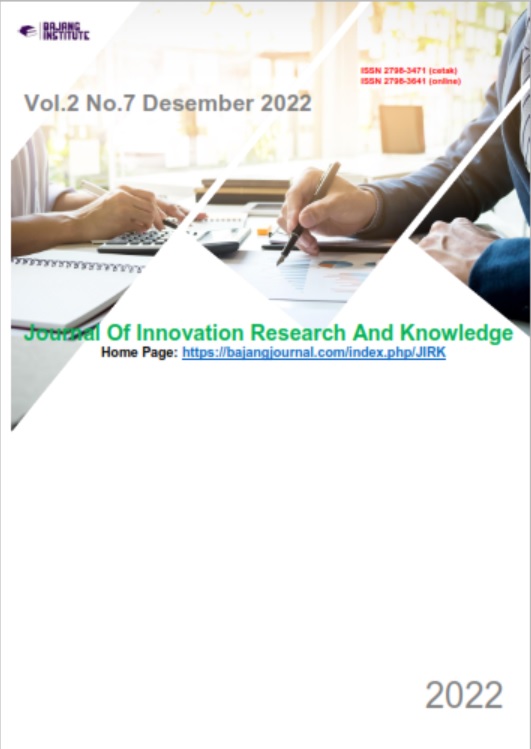CASE STUDY: PROGRAM FISIOTERAPI PADA KASUS POST PARTUM SECTIO CAESAREA ET CAUSA IUGR OLIGOHIDRAMNION
DOI:
https://doi.org/10.53625/jirk.v2i7.4211Keywords:
Sectio Caesarea, deep breathing exercise, pelvic floor exercise, ankle pumping, latihan mobilisasiAbstract
Pendahuluan: Sectio Caesarea (SC) merupakan suatu cara melahirkan janin dengan membuat sayatan pada dinding rahim. Masalah kesehatan yang dapat dialami oleh wanita post SC antara lain nyeri, oedem pada kaki, dan menurunnya kemampuan fungsional. Tujuan: untuk mengetahui efek deep breathing, pelvic floor exercise, ankle pumping exercise, latihan mobilisasi, dan breast care terhadap intensitas nyeri, oedem pada kaki, dan kemampuan fungsional pada pasien Post Partum Sectio Caesarea et causa IUGR Oligohidramnion. Metode: Metode penelitian ini dilakukan secara langsung kepada satu responden dengan kasus Post Partum Sectio Caesarea et causa IUGR Oligohidramnion dengan pemberian terapi sebanyak 3 kali sesi terapi. Pengukuran intensitas nyeri menggunakan Numerical Rating Scale, oedem pada kaki menggunakan metline, dan kemampuan fungsional menggunakan The Barthel Index. Hasil: Setelah dilakukan terapi sebanyak 3 kali didapatkan hasil NRS nyeri diam dari 6 ke 2, nyeri tekan dari 9 ke 7, dan nyeri gerak dari 8 ke 4. Pengukuran oedem kaki kanan pada titik 5 cm proksimal mal lateralis dari 22,4 cm ke 22,2 cm, 0 cm mal lateralis dari 24 cm ke 23 cm, 5 cm distal mal lateralis dari 22 cm ke 23 cm. Oedem kaki kiri pada titik 5 cm proksimal mal lateralis dari 23 cm ke 22,9 cm, 0 cm mal lateralis dari 24,3 cm ke 24,2 cm, 5 cm distal mal. Lateralis dari 23 cm ke 22,8 cm. Hasil The Barthel Index dari 20 menjadi 65. Kesimpulan: penggunaan deep breathing, pelvic floor exercise, ankle pumping exercise, latihan mobilisasi, dan breast care dapat menurunkan intensitas nyeri, menurunkan oedem pada kaki, dan meningkatkan kemampuan fungsional pada pasien post SC et causa IUGR Oligohidramnion.
References
Appulembang, I., & Abu, A. (2019). Deep Breathing Relaxation Technique toward Decrease Pain Intensity in Post Operative Patients at Mamuju District Public Hospital. Interprofessional Proceedings Collaboration on Urban Health, 2(1). https://doi.org/https://doi.org/10.32382/uh.v2i1
Borges, J. B. R., Guarisi, T., Camargo, A. C. M. de, Gollop, T. R., Machado, R. B., & Borges, P. C. de G. (2010). Urinary incontinence after vaginal delivery or cesarean section. Einstein (São Paulo), 8(2), 192–196. https://doi.org/10.1590/s1679-45082010ao1543
Chauhan, S. P., Taylor, M., Shields, D., Parker, D., Scardo, J. A., & Magann, E. F. (2007). Intrauterine growth restriction and oligohydramnios among high-risk patients. American Journal of Perinatology, 24(4), 215–222. https://doi.org/10.1055/s-2007-972926
Corrado, B., Giardulli, B., Polito, F., Aprea, S., Lanzano, M., & Dodaro, C. (2020). The impact of urinary incontinence on quality of life: A cross-sectional study in the metropolitan city of Naples. Geriatrics (Switzerland), 5(4), 1–14. https://doi.org/10.3390/geriatrics5040096
Gupta, S., Yadav, R., & Malhotra, A. (2016). Assessment of physical disability using Barthel index among elderly of rural areas of district Jhansi (U.P), India. Journal of Family Medicine and Primary Care, 5(4), 853. https://doi.org/10.4103/2249-4863.201178
Hadizadeh-Talasaz, Z., Sadeghi, R., & Khadivzadeh, T. (2019). Effect of pelvic floor muscle training on postpartum sexual function and quality of life: A systematic review and meta-analysis of clinical trials. Taiwanese Journal of Obstetrics and Gynecology, 58(6), 737–747. https://doi.org/10.1016/j.tjog.2019.09.003
Karakaya, A. C., Yüksel, Ä., Akbayrak, T., Demirtürk, F., Karakaya, M. G., Özyüncü, Ö., & Beksaç, S. (2012). EVects of physiotherapy on pain and functional activities after cesarean delivery. Archives of Gynecology and Obstetrics, 285(3), 621–627. https://doi.org/10.1007/s00404-011-2037-0
Marfuah, D., Nurhayati, N., Mutiar, A., Sumiati, M., & Mardiani, R. (2019). Pain Intensity among Women with Post-Caesarean Section: A Descriptive Study. KnE Life Sciences, 2019, 657–663. https://doi.org/10.18502/kls.v4i13.5322
Nurdianty, Ansariadi, & Masni. (2020). Determinants of the indications of sectio caesarea in Makassar city hospital. Enfermeria Clinica, 30, 349–352. https://doi.org/10.1016/j.enfcli.2019.10.098
Perwiraningtyas, P., & Rahmawati, A. (2021). Factor Analysis of Caesarean Section at Panti Waluya Hospital, Malang. Jurnal Ners Dan Kebidanan (Journal of Ners and Midwifery), 8(3), 276–283. https://doi.org/10.26699/jnk.v8i3.art.p276-283
Prastika, Supono, & Sulastyawati. (2019). Ankle Pumpling Exercise and Leg Elevation in 30O Has the Same Level of Effectiveness To Reducing Foot Edema At Chronic Renal Failure Patients In Mojokerto. International Conference of Kerta Cendekia Nursing Academy-2019, 241–248. Retrieved from http://ejournal-kertacendekia.id/index.php/ICKCNA/article/view/109
Razan, A., & Wijianto, W. (2021). The effectiveness of mobilization in improving mother’s functional status after caesarean section delivery. Academic Physiotherapy Conference Proceeding, 542–546.
Sheng, Y., Carpenter, J. S., Ashton-Miller, J. A., & Miller, J. M. (2022). Mechanisms of pelvic floor muscle training for managing urinary incontinence in women: a scoping review. BMC Women’s Health, 22(1), 1–16. https://doi.org/10.1186/s12905-022-01742-w
Tapar, H., Karaman, S., Dogru, S., Karaman, T., & Dogru, H. Y. (2019). Evaluation of Postoperative Analgesic Consumption After Emergency and Elective Cesarean Section. Gynecology Obstetrics & Reproductive Medicine, 25(2), 70–73. https://doi.org/10.21613/gorm.2018.778
Tarukallo, J. S., Lotisna, D., & Pelupessy, N. U. (2018). Effect of Postpartum Pelvic Floor Muscles Training in Pelvic Floor Muscles Strength on Postpartum Women with Stress Urinary Incontinence. Indonesian Journal of Obstetrics and Gynecology, 114. https://doi.org/10.32771/inajog.v6i2.772
Toya, K., Sasano, K., Takasoh, T., Nishimoto, T., Fujimoto, Y., Kusumoto, Y., … Takahashi, T. (2016). Ankle positions and exercise intervals effect on the blood flow velocity in the common femoral vein during ankle pumping exercises. Journal of Physical Therapy Science, 28(2), 685–688. https://doi.org/10.1589/jpts.28.685
Weerasinghe, K., Rishard, M., Brabaharan, S., & Mohamed, A. (2022). Effectiveness of face-to-face physiotherapy training and education for women who are undergoing elective caesarean section: a randomized controlled trial. Archives of Physiotherapy, 12(1), 1–10. https://doi.org/10.1186/s40945-021-00128-9
Widayati, D. S., Firdaus, A. D., & Handian, F. I. (2022). The Relationship Between Level of Knowledge About Early Mobilization with Pain Intensity of Post Laparotomy Patients. The Journal of Palembang Nursing Studies, 1(2), 28–33. https://doi.org/10.55048/jpns.v1i2.11
Wijayanti, T., & Setiyaningsih, A. (2016). Efektifitas Breast Care Post Partum Terhadap Produksi Asi. Jurnal Kebidanan, 8(02), 201–208. https://doi.org/10.35872/jurkeb.v8i02.224
Youness, E., & Ibrahim, W. (2017). Effect of early and progressive exercises on post-caesarean section recovery among women attending women’s heath hospital. International Journal of Advanced Nursing Studies, 6(2), 71. https://doi.org/10.14419/ijans.v6i2.7660
Yusita, I., Effendi, J., & Pragholapati, A. (2020). Pengaruh Pelvic Floor Muscle Training Terhadap Fungsi Defekasi Pada Ibu Postpartum Spontan.: Effect of Pelvic Floor Muscle Training on Defecation Function in Spontaneous Postpartum Mothers. Bali Medika Jurnal, 7(1), 86–92.













